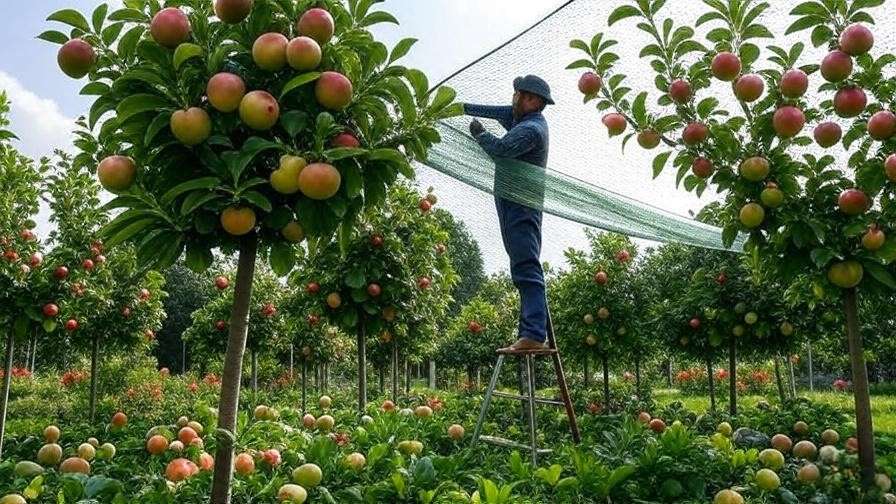Imagine stepping into your garden, heart swelling with pride as you admire your fruit trees laden with ripening apples, cherries, or peaches—only to find birds, squirrels, or insects have claimed your harvest first. It’s a gut-wrenching moment for any gardener. Fruit tree netting is your solution to safeguard your precious crops from these threats, ensuring you enjoy the fruits of your labor. This comprehensive guide will walk you through everything you need to know about choosing, installing, and maintaining fruit tree netting, with expert insights to help you maximize your harvest. Whether you’re a home gardener or a small-scale farmer, you’ll find actionable tips to protect your trees effectively. Let’s dive in! 🌿
1. Why Fruit Tree Netting Is Essential for Your Garden 🍑
Fruit trees are a labor of love, but they face constant threats that can diminish or destroy your yield. From pesky birds to sneaky insects, unprotected trees are vulnerable. Fruit tree netting offers a practical, eco-friendly way to shield your crops, ensuring you reap the rewards of your hard work.
1.1 The Threats to Your Fruit Trees 🐦
Your fruit trees are a buffet for wildlife and environmental hazards. Birds like sparrows and starlings can peck away at cherries or apples, leaving behind damaged, unsalvageable fruit. Squirrels and rodents nibble on peaches and plums, while insects like codling moths or fruit flies lay eggs that ruin your crop. Weather elements, such as hail or strong winds, can bruise or knock fruit off branches. According to a 2023 study by the University of California Extension, unprotected orchards can lose up to 40% of their yield to pests and weather damage. For home gardeners, this loss can feel devastating, both emotionally and financially.
1.2 Benefits of Using Fruit Tree Netting 🌿
Fruit tree netting is a game-changer for gardeners. Here’s why:
- Pest Protection: Netting creates a physical barrier, keeping birds, squirrels, and insects at bay.
- Weather Defense: It shields fruit from hail, wind, and excessive sun exposure, preserving quality.
- Higher Yields: By reducing losses, netting ensures more fruit makes it to your table.
- Eco-Friendly Solution: Unlike chemical pesticides, netting is non-toxic and safe for the environment.
- Cost Savings: A one-time investment in durable netting saves money compared to repeated pest control treatments.
For example, Jane, a backyard gardener in Oregon, reported a 70% increase in her cherry harvest after using netting, proving its value for small-scale growers.
2. Types of Fruit Tree Netting: Which One Is Right for You? 🛒
Not all fruit tree netting is created equal. Understanding the different types and their features will help you choose the best option for your garden’s needs.
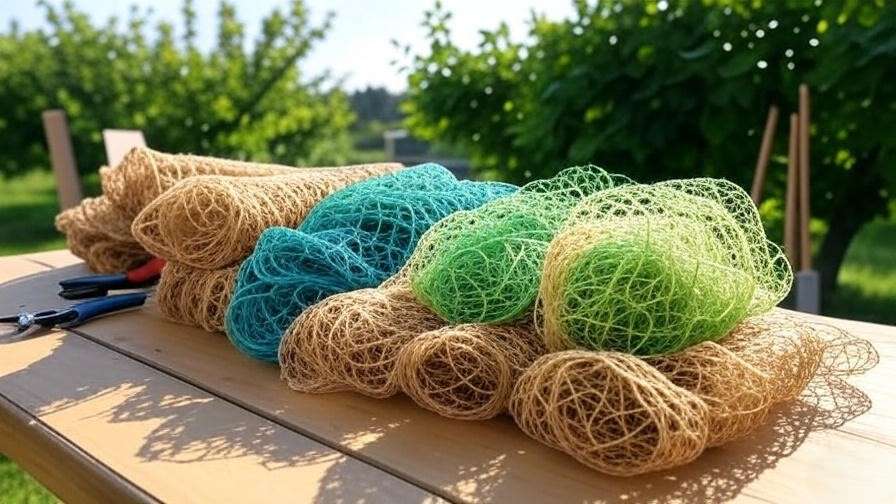
2.1 Material Options for Netting 🧵
Netting comes in various materials, each with unique benefits:
- Polyethylene: Lightweight, affordable, and durable, ideal for most home gardens. UV-resistant options last multiple seasons.
- Nylon: Stronger and more tear-resistant, perfect for larger trees or windy areas, though slightly pricier.
- Biodegradable Netting: Made from natural fibers like jute, these eco-friendly options decompose after use but may need frequent replacement.
Mesh size matters too. Fine mesh (1/4 inch or smaller) blocks tiny insects like fruit flies, while larger mesh (1/2 inch) is sufficient for birds and squirrels. Always check for UV resistance to ensure longevity.
2.2 Netting Styles and Designs 🎨
Netting comes in various forms to suit different trees and needs:
- Drape Netting: Loose netting draped over trees, ideal for small or young trees. Easy to install but may leave gaps.
- Structured Netting: Uses frames, hoops, or cages for a snug fit, perfect for larger or orchard-style trees.
- Tree Bags: Small mesh bags that cover individual branches or fruit clusters, great for precise protection.
- Specialty Netting: Options like anti-bird netting (larger mesh) or hail-proof netting (thicker material) cater to specific threats.
2.3 Expert Tip 💡
To help you choose, here’s a quick comparison table:
| Netting Type | Best For | Cost | Durability |
|---|---|---|---|
| Polyethylene Drape | Small trees, budget-conscious gardeners | $10–$30 | 2–5 years |
| Nylon Structured | Large trees, windy areas | $20–$50 | 5–10 years |
| Biodegradable | Eco-friendly gardens | $15–$40 | 1–2 seasons |
| Tree Bags | Specific branches, small fruits | $5–$20 | 1–3 years |
For sustainable gardeners, biodegradable netting from brands like GreenHarvest is a great choice, though it requires annual replacement.
3. How to Choose the Best Fruit Tree Netting for Your Needs 🌍
Selecting the right netting depends on your garden’s unique conditions. Here’s how to make an informed decision.
3.1 Assessing Your Garden’s Needs 📏
Start by evaluating:
- Tree Size and Species: Smaller trees like dwarf apples need less netting than sprawling peach trees. Citrus trees may require finer mesh for insect protection.
- Local Threats: Identify common pests in your area (e.g., crows in the Midwest, fruit bats in tropical regions) and weather challenges (e.g., hail in the Great Plains).
- Budget: Durable nylon netting costs more upfront but lasts longer, while polyethylene is budget-friendly for beginners.
For example, a gardener in Florida might prioritize fine-mesh netting to block citrus psyllids, while one in Washington might focus on bird protection for cherries.
3.2 Key Features to Look For 🔍
When shopping for netting, prioritize:
- Ease of Use: Look for lightweight netting with pre-attached ties or clips for quick installation.
- Reusability: Choose UV-resistant, tear-proof materials for multi-season use.
- Breathability: Ensure the netting allows air circulation to prevent mold or overheating.
- Fit: Confirm the netting size matches your tree’s canopy, with extra room for growth.
3.3 Common Mistakes to Avoid 🚫
- Wrong Mesh Size: Too large, and insects sneak through; too small, and it restricts airflow.
- Underestimating Coverage: Measure your tree’s full canopy to avoid gaps.
- Skipping Maintenance: Dirty or damaged netting loses effectiveness and may harm trees.
Dr. Emily Carter, a horticulturist at Cornell University, advises, “Always measure your tree’s canopy and account for growth when buying netting. A poor fit can negate all your efforts.”
4. Step-by-Step Guide to Installing Fruit Tree Netting 🛠️
Proper installation is key to ensuring your netting works effectively. Follow these steps for a secure setup.
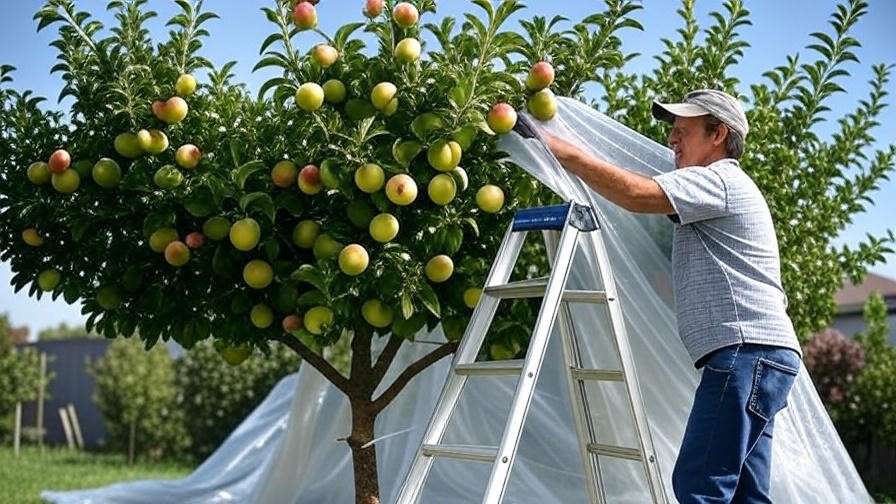
4.1 Preparation Before Netting 🧹
- Prune Your Tree: Trim dead or overgrown branches to make netting easier to apply and reduce stress on the tree.
- Measure the Canopy: Use a tape measure to determine the tree’s height and width, adding 10–20% for overlap.
- Gather Tools: You’ll need poles, stakes, zip ties, or clips. A ladder may be necessary for taller trees.
4.2 Installation Techniques for Different Tree Types 🌲
- Small or Young Trees: Drape netting over the entire tree, securing it at the trunk with ties or weights. Ensure no gaps remain at the base.
- Large Trees: Use a frame or hoop system to support structured netting. Anchor the frame to the ground with stakes for stability.
- Branch-Specific Protection: For smaller yields, cover individual branches with tree bags, tying them securely to prevent pest entry.
4.3 Safety Tips for Installation ⚠️
- Avoid pulling netting too tightly, as it can damage branches or bark.
- Check for gaps daily to ensure no pests sneak through.
- Use a sturdy ladder and have a helper for tall trees to prevent falls.
- Choose wildlife-friendly netting with larger mesh to avoid trapping beneficial insects or small birds.
Expert Insight: “When installing netting, think like a pest,” says orchard manager Tom Rivera. “If there’s even a small gap, they’ll find it. Double-check your setup after storms or high winds.”
4.4 Downloadable Checklist 📋
To streamline your installation process, download our free fruit tree netting checklist, which includes a step-by-step guide and a list of necessary tools. This ensures you don’t miss any critical steps, making your setup efficient and effective.
5. Maintaining and Storing Your Fruit Tree Netting for Longevity 🧼
To maximize the lifespan of your fruit tree netting and ensure it remains effective season after season, proper maintenance and storage are crucial. Here’s how to keep your netting in top shape.
5.1 Cleaning and Repairing Netting 🪡
- Cleaning: After each season, rinse netting with a garden hose to remove dirt, sap, or pest residue. For stubborn stains, soak in a mild soap solution (avoid harsh chemicals that degrade materials). Air-dry completely to prevent mold.
- Repairing: Inspect for tears or holes. Small rips can be fixed with UV-resistant thread or netting repair tape, available at garden centers. For larger damage, consider replacing the section to maintain protection.
- When to Replace: If netting shows signs of fraying, thinning, or UV degradation (e.g., brittleness or discoloration), replace it to avoid pest breaches.
5.2 Proper Storage Techniques 📦
- Fold Carefully: Roll or fold netting loosely to avoid creases that weaken the material. Avoid tight knots that cause tangling.
- Store in a Dry Place: Keep netting in a breathable storage bag or container to prevent moisture buildup. Avoid damp basements or sheds prone to rodent activity.
- Protect from UV Damage: Store away from direct sunlight during the off-season to extend durability.
- Organize Multiple Sets: If you have netting for different trees, label each set with the tree type or size for easy reuse next season.
Expert Tip: “Treat your netting like an investment,” says arborist Sarah Nguyen. “Proper cleaning and storage can double its lifespan, saving you money and hassle in the long run.”
6. Troubleshooting Common Fruit Tree Netting Issues 🐞
Even with the best netting, issues can arise. Here’s how to address common problems to keep your trees protected.
6.1 Netting Slipping or Gaps Forming 🔧
- Problem: Wind or animal activity can cause netting to slip, creating gaps for pests.
- Solution: Secure netting with additional zip ties, clips, or weights (e.g., rocks or sandbags) at the base. For drape netting, use stakes to anchor it to the ground. Check after storms to ensure a tight fit.
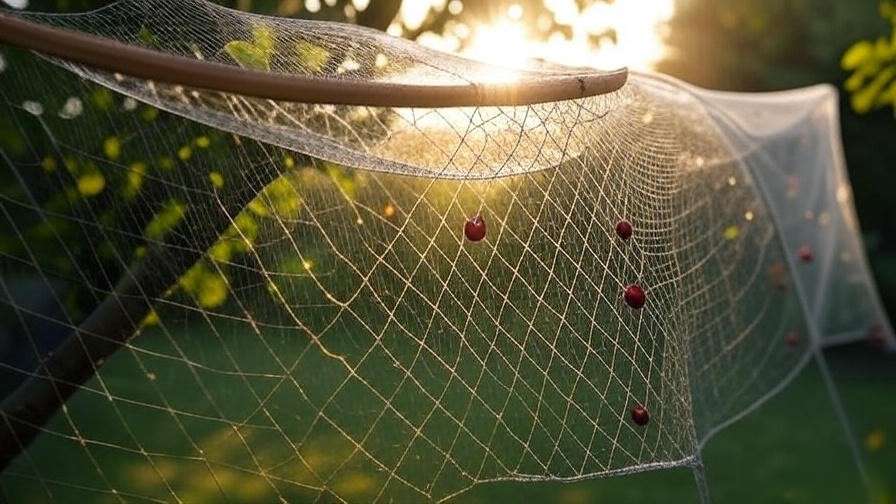
6.2 Managing Trapped Wildlife 🦋
- Problem: Birds or beneficial insects like bees may get caught in fine-mesh netting.
- Solution: Check netting daily and gently release trapped wildlife. Opt for larger mesh sizes (1/2 inch) for bird protection to minimize entrapment while still deterring pests. If trapping persists, consider structured netting with a frame to keep the material taut and away from branches.
6.3 Preventing Overheating or Mold 🍂
- Problem: Poorly ventilated netting can trap heat or moisture, leading to mold or fruit damage.
- Solution: Choose breathable materials like polyethylene or nylon with adequate mesh size. Monitor trees in humid climates for fungal growth and remove netting temporarily during heavy rain to improve airflow.
Case Study: A Michigan apple grower faced mold issues under tightly draped netting. Switching to a structured hoop system with breathable polyethylene netting reduced humidity and saved 90% of their crop.
7. Eco-Friendly and Sustainable Netting Practices 🌱
Sustainability is a growing concern for gardeners. Fruit tree netting can align with eco-conscious practices without sacrificing effectiveness.
7.1 Choosing Biodegradable or Recyclable Netting ♻️
- Biodegradable Options: Netting made from jute or hemp decomposes naturally, reducing waste. Brands like EcoNet offer biodegradable options for small trees, though they require annual replacement.
- Recyclable Materials: Polyethylene and nylon netting can often be recycled at local facilities. Check with your municipality for recycling programs.
- Pros and Cons: Biodegradable netting is eco-friendly but less durable, while recyclable synthetic netting lasts longer but requires proper disposal.
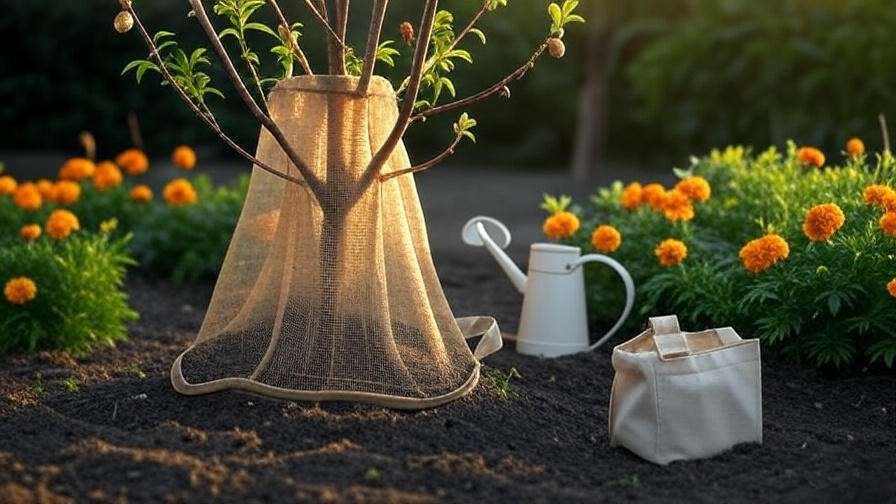
7.2 Reducing Environmental Impact 🌎
- Reuse Netting: Invest in durable, UV-resistant netting to use across multiple seasons, reducing waste.
- Combine with Natural Deterrents: Pair netting with companion planting (e.g., marigolds to repel insects) or reflective tape to deter birds, minimizing reliance on extensive netting.
- Support Pollinators: Remove netting during pollination season or use larger mesh to allow bees access, ensuring healthy fruit production.
Expert Insight: “Sustainable netting practices not only protect your harvest but also support a healthier ecosystem,” notes Dr. Maria Lopez, an environmental horticulturist. “Choose reusable materials and integrate natural pest control for the best results.”
8. Real-Life Success Stories: How Netting Saved Harvests 🍒
Nothing illustrates the value of fruit tree netting like real-world examples. Here are two success stories:
- Emma’s Cherry Orchard (Washington): Emma, a small-scale cherry grower, lost half her crop to birds annually. After installing UV-resistant nylon netting with a hoop system, her yield doubled, and she saved $1,200 in potential losses. “The netting paid for itself in one season,” she says.
- Mark’s Backyard Peaches (Georgia): Mark struggled with squirrels eating his peaches. Switching to individual tree bags for his two peach trees, he protected 95% of his fruit, enjoying his first full harvest in years.
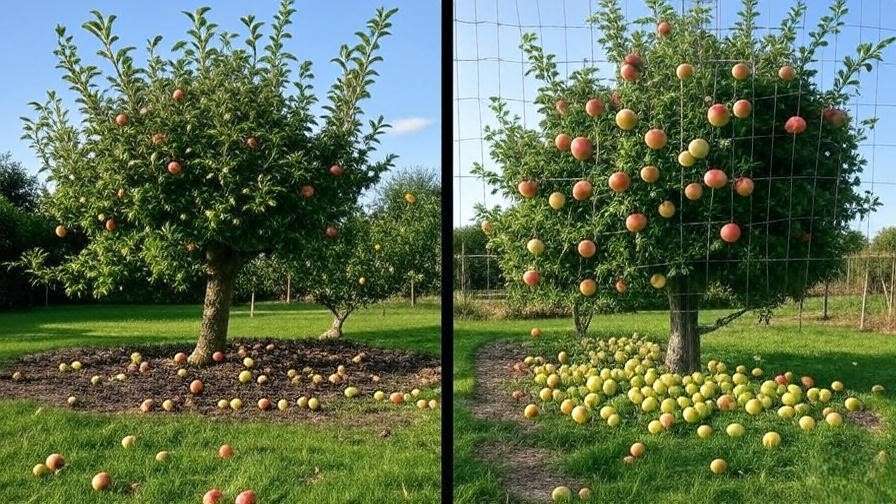
Visual Idea: Include before-and-after photos of netted trees (with alt text like “Netted apple tree protecting fruit from birds”) to boost engagement and SEO.
9. FAQs About Fruit Tree Netting ❓
Here are answers to common questions gardeners ask about fruit tree netting:
- What is the best netting for small fruit trees? Lightweight polyethylene drape netting is ideal for small trees like dwarf apples or cherries due to its affordability and ease of use.
- How often should I replace fruit tree netting? Durable nylon or UV-resistant polyethylene can last 5–10 years with proper care, while biodegradable netting needs annual replacement.
- Can fruit tree netting harm birds or pollinators? Fine-mesh netting can trap small wildlife. Opt for larger mesh (1/2 inch) or check netting daily to release trapped animals safely.
- Is fruit tree netting worth the investment for home gardeners? Yes, netting prevents significant crop loss, often paying for itself in one season by increasing yields.
- How do I know what size netting to buy for my tree? Measure your tree’s canopy (height and width) and add 10–20% for overlap. For example, a 10-foot tree needs at least 12 feet of netting.
- Can I use fruit tree netting for other plants or crops? Yes, netting can protect berry bushes, vineyards, or vegetable gardens from similar pests.
10. Conclusion: Secure Your Harvest with Confidence 🎉
Fruit tree netting is a gardener’s best friend, offering a reliable, eco-friendly way to protect your harvest from birds, insects, and weather. By choosing the right netting, installing it correctly, and maintaining it properly, you can enjoy bountiful yields year after year. Whether you’re safeguarding a single backyard tree or an entire orchard, this guide provides the expert-backed tools and tips you need to succeed. Start protecting your fruit trees today, and share your netting success stories in the comments below! Explore our other plant care articles for more ways to nurture your garden. 🌻

